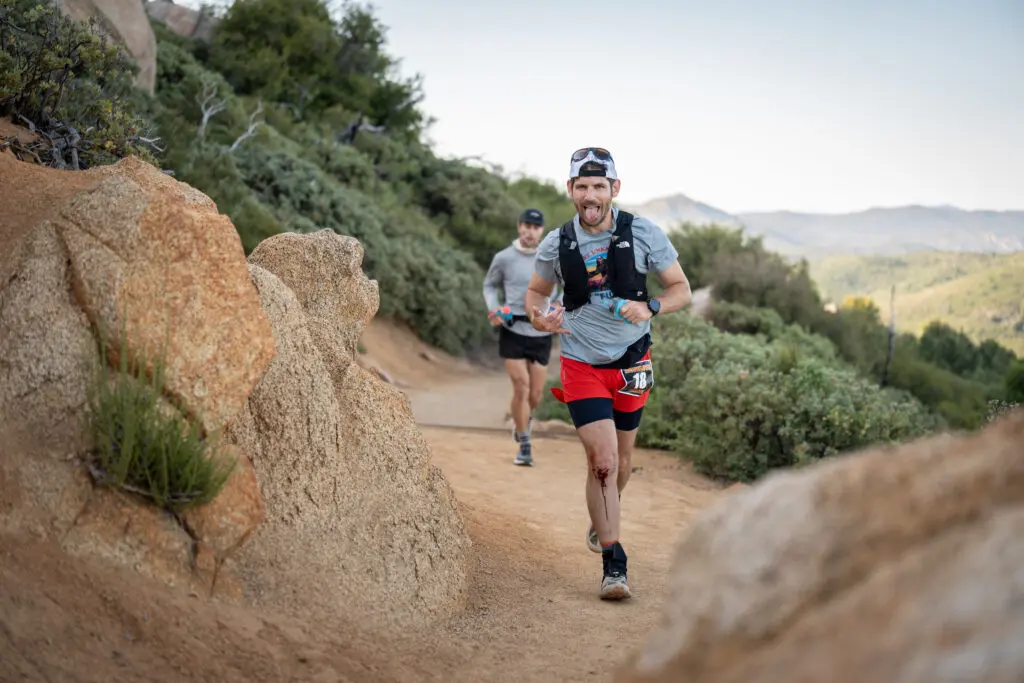Was A Podium Finish at San Diego 100 in the Realm of Possibility?
By: Joshua Goldstein
Posted:

Short answer – probably not! Set a goal. Build a plan. Go big. Miss. Adjust. Get revenge.
This season’s project was a big question: Could I train smart and race hard enough to podium a 100-miler on just 10 hours a week, all while balancing a full-time job and commitments to family, friends, and community?
My test case was the San Diego 100. I was in 15th place at mile 32, took a wrong turn, ran six bonus miles, and dropped at mile 41. On the upside, I’m pretty sure I can convince the race director, BJ, to name the turn after me next year.
But the only reason to ask the podium question is to find ways to improve. So, what can we learn from those first 32 miles?
I set splits for a very aggressive 19:18 finish. Here’s how my actual race stacked up against that plan:
The drop in position isn’t the key clue—race placement fluctuates. The signal is that I slowed significantly on the long descent into Green Valley. That’s a red flag. I’m typically stronger on downhills than climbs, so if I’m fading here, I likely overcooked the prior climb, even though I was hitting my target pace.
Does that align with how the race felt? Mostly, yes. I knew I was pushing harder than I ever had in a 100-miler—probably harder than in most 50-milers—but I wanted to test whether my fitness, fueling, and strength work could carry me. This time, they couldn’t. The Green Valley descent felt sluggish compared to the earlier drop to Trout Pond, and the data confirmed it. That said, Amanda’s ice bucket and a fresh shirt at the Green Valley aid station absolutely revived me. I felt great heading out… right into the wrong turn. So, who knows for sure?
My theory was that after 15 years of ultrarunning, my aerobic base was solid. This turned out to be correct. I ran a spicy 10:08 NGP (vert-adjusted pace) for 32 miles with 5,300 feet of gain, all while maintaining an average heart rate of 156 bpm (low Zone 2) and never spiking above 175 (my approximate Z2 ceiling).
My training focused on a mix of muscular endurance (ME) to build resistance to neuromuscular fatigue, and speed work to improve running economy. In retrospect, the balance was wrong. I phased out deadlifts (my posterior chain is wildly weak relative to my anterior) and probably did 5-7 times more speed workouts than ME sessions.
I did introduce downhill sprints in the final training block—likely the single best workout I could do—but it was too much, too late. The sessions absolutely fried my quads and led to significant DOMS, and I might have been feeling the remnants of that on the starting line.
I experimented with an aggressive 10-day taper. In general I like this approach, but given the muscular fatigue I was experiencing, In the future, I’ll extend my taper to 14 days to ensure I’m fully rested for these longer efforts, especially since neuromuscular fatigue, not aerobic capacity, appears to be my limiting factor.
I knew this was a risk going into the race. The course starts at 5,000 feet, and my watch recorded a high of 106°F in exposed canyon sections. I wasn’t able to incorporate sauna training or spend adequate time at altitude, and it definitely impacted my performance.
Here, the data is clear. According to my sweat test, I lose 1,249 mg of sodium per liter of sweat. The suggested replacement rate is closer to 1,000 mg/L. During the race, I took in about 614 mg per hour while drinking roughly a liter of water per hour. This put me at only 60% of my target sodium intake.
I have to confess, I didn’t feel low on sodium, but the numbers don’t lie. Moving forward, I plan to decouple my sodium from my hydration to make it easier to manage intake accurately. My nutrition, on the other hand, was spot on at 120g of carbs per hour.
With the exception of wrong turns, you can never attribute success or failure to a single variable. You just have to try a bunch of things and see what works. That’s one of the many things that makes ultrarunning such a fascinating sport.
I’m eyeing the Cuyamaca 100k for a shot at redemption in the same mountains. In the meantime, who’s ready for hill sprints?
Josh Goldstein is an ultrarunner based in Los Angeles, California. He has completed dozens of ultramarathons, including two finishes at the Tahoe 200.